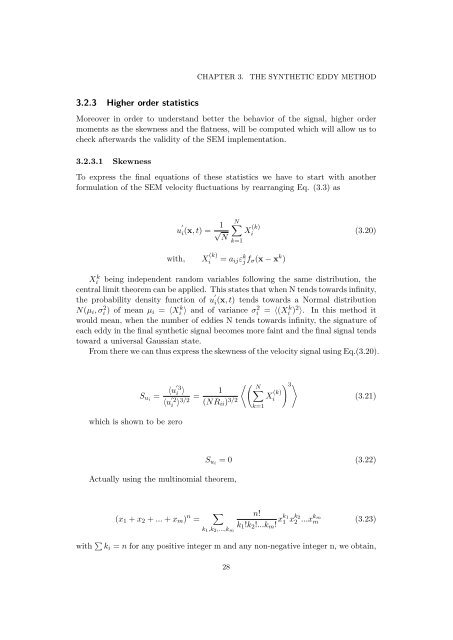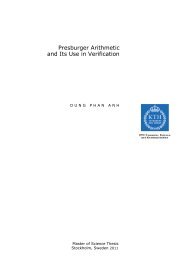Synthetic Inflow Condition for Large Eddy Simulation (Synthetic - KTH
Synthetic Inflow Condition for Large Eddy Simulation (Synthetic - KTH
Synthetic Inflow Condition for Large Eddy Simulation (Synthetic - KTH
Create successful ePaper yourself
Turn your PDF publications into a flip-book with our unique Google optimized e-Paper software.
3.2.3 Higher order statistics<br />
CHAPTER 3. THE SYNTHETIC EDDY METHOD<br />
Moreover in order to understand better the behavior of the signal, higher order<br />
moments as the skewness and the flatness, will be computed which will allow us to<br />
check afterwards the validity of the SEM implementation.<br />
3.2.3.1 Skewness<br />
To express the final equations of these statistics we have to start with another<br />
<strong>for</strong>mulation of the SEM velocity fluctuations by rearranging Eq. (3.3) as<br />
u ′<br />
i(x, t) = 1<br />
√ N<br />
with, X (k)<br />
i<br />
N�<br />
k=1<br />
X (k)<br />
i<br />
= aijε k j fσ(x − x k )<br />
(3.20)<br />
Xk i being independent random variables following the same distribution, the<br />
central limit theorem can be applied. This states that when N tends towards infinity,<br />
the probability density function of u ′<br />
i (x, t) tends towards a Normal distribution<br />
N(µi, σ 2 i ) of mean µi = 〈X k i 〉 and of variance σ2 i = 〈(Xk i )2 〉. In this method it<br />
would mean, when the number of eddies N tends towards infinity, the signature of<br />
each eddy in the final synthetic signal becomes more faint and the final signal tends<br />
toward a universal Gaussian state.<br />
From there we can thus express the skewness of the velocity signal using Eq.(3.20).<br />
Sui = 〈u′ 3<br />
i 〉<br />
〈u ′ = 2<br />
i 〉 3/2<br />
which is shown to be zero<br />
1<br />
(NRii) 3/2<br />
��<br />
N�<br />
X<br />
k=1<br />
(k)<br />
�3�<br />
i<br />
Sui<br />
Actually using the multinomial theorem,<br />
(x1 + x2 + ... + xm) n =<br />
�<br />
k1,k2,...,km<br />
(3.21)<br />
= 0 (3.22)<br />
n!<br />
k1!k2!...km! xk1 1 xk2 2 ...xkm m<br />
(3.23)<br />
with � ki = n <strong>for</strong> any positive integer m and any non-negative integer n, we obtain,<br />
28

















